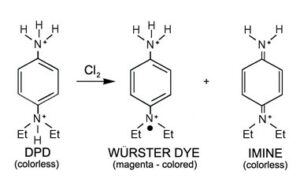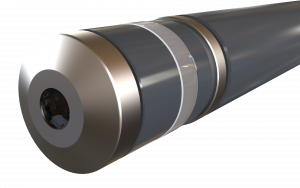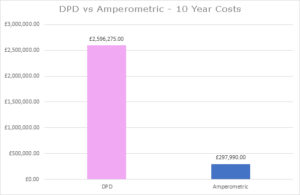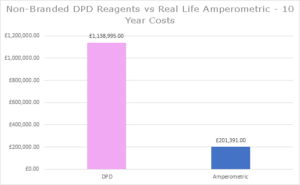For many years, online DPD measurement of free chlorine has been seen as the most reliable, and best, way to ensure an accurate measurement of free chlorine in water. However, over the past 20 years, huge advances have been made in amperometric measurements with little or no advancements made in DPD measurement technology, so is online DPD still the best way to measure chlorine in water?
Did you know that…
…Pi’s amperometric chlorine probes only require maintenance once a year?
…Pi’s amperometric range of probes do not use reagents and therefore have no ongoing running costs?
…a utility company saved £millions when they swapped from online DPD to Pi’s amperometric free chlorine probes?

DPD based systems
This technology uses the chemical reaction between DPD (N.N-diethyl-p-phenylenediamine) and an oxidant, e.g. free chlorine, to measure the oxidant level. The chemical reaction causes a visible change from colorless to pink, which is proportional to the level of oxidant.
Free chlorine is measured by adding a precisely measured amount of DPD reagent to the sample, along with a pH stabilizing buffer to maintain the pH between 6.3 and 6.6. Total chlorine can be measured by adding iodine and reducing the pH to 5.1.
The DPD reaction requires precise measurement of the DPD chemical, sample volume and buffer to ensure that the reaction is reproducible and accurate. To do this, DPD based online systems require very accurate dosing measurements and fine tubing to carry the precise volumes. To keep a DPD based online system working correctly, it is essential that the instrument is serviced annually with all tubing replaced. The reagents used in the DPD chemical reaction also require monthly replacement which, when combined with the cost of the service kit and time taken to complete the maintenance tasks, means that the ongoing maintenance costs are much more than the instrument purchase price. As many companies are taking more notice of total costs (Totex) rather than just the initial equipment costs (Capex), DPD based online systems are beginning to look less appealing.

Amperometric based systems
These use electrochemistry to measure the chlorine concentration. The current produced by the reduction of chlorine is measured and this current is proportional to the amount of chlorine present. Amperometric probes can measure free or total chlorine. Many other oxidants such as peracetic acid, chlorine dioxide and ozone can be measured with oxidant specific amperometric probes.
Traditionally, amperometric probes required 2-point calibrations, regular cleaning, pH compensation/pH buffering and very precise flow control. This meant that they required lots of maintenance or didn’t give accurate results. This is no longer the case.
Amperometric probes have gone through multiple technological changes over the past 20 years and the result of these means that modern day amperometric sensors suffer from none of these issues. Amperometric probes that utilize all of the technological discoveries, like the ones supplied by Pi, only require single point calibration because zero drift has been completely eradicated.
In clean applications, they require no cleaning. In dirty applications, Pi can provide automatic flushing systems to keep the sensor clean and functioning. This is all down to new membrane materials. They do not require pH compensation or buffering except in the most extreme and variable pH applications, and flow variations have been minimized to a negligible level due to improved flow cell designs. All of these improvements mean that the advantages once enjoyed by DPD measurement technologies are now non-existent and amperometric technology is quite understandably becoming the standard in nearly all applications.
Case Study – Savings made when switching from DPD to amperometric measurement
 More than ten years ago, a large UK water utility company made the decision to remove all of their DPD based, chlorine measurement instruments and replace them with Pi’s HaloSense amperometric chlorine analyzers. This puts Pi in a unique position to accurately calculate the savings made by this water company as a direct result of this change.
More than ten years ago, a large UK water utility company made the decision to remove all of their DPD based, chlorine measurement instruments and replace them with Pi’s HaloSense amperometric chlorine analyzers. This puts Pi in a unique position to accurately calculate the savings made by this water company as a direct result of this change.
330 DPD based instruments were removed and Pi’s HaloSense chlorine systems were installed over a period of 6 months. The first graph shows the calculated savings made by this UK water company over ten years using the current list prices for maintenance parts and reagents. This shows that, at current prices, savings of £2.3million would have been made over this ten year period. The figures don’t include the savings made through the reduction of monthly DPD replacement visits.
 It is possible to purchase non-branded reagents for DPD based systems which does reduce the ongoing cost of these systems. However, real world data of the 330 amperometric systems installed also shows that maintenance times of the installed amperometric probes could be extended in most cases, well beyond the recommended frequency, which also reduces the cost of the amperometric systems. Taking both of these factors into account, the second graph shows the adjusted savings which, in this real world example, still adds up to £937,000.
It is possible to purchase non-branded reagents for DPD based systems which does reduce the ongoing cost of these systems. However, real world data of the 330 amperometric systems installed also shows that maintenance times of the installed amperometric probes could be extended in most cases, well beyond the recommended frequency, which also reduces the cost of the amperometric systems. Taking both of these factors into account, the second graph shows the adjusted savings which, in this real world example, still adds up to £937,000.
Coupling an amperometric probe with Pi’s CRIUS®4.0 controller makes it possible to not only reduce maintenance costs but to also reduce emergency callouts and unscheduled maintenance work by utilizing the CRIUS®4.0 pro-active maintenance warnings and remote communications, whilst also improving the overall quality of measurement results.









